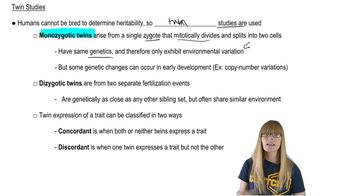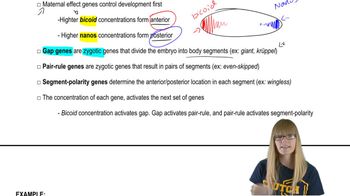What is the statistical principle underlying genetic health risk assessment? Why are these assessments not predictive of disease occurrence?
Table of contents
- 1. Introduction to Genetics51m
- 2. Mendel's Laws of Inheritance3h 37m
- 3. Extensions to Mendelian Inheritance2h 41m
- 4. Genetic Mapping and Linkage2h 28m
- 5. Genetics of Bacteria and Viruses1h 21m
- 6. Chromosomal Variation1h 48m
- 7. DNA and Chromosome Structure56m
- 8. DNA Replication1h 10m
- 9. Mitosis and Meiosis1h 34m
- 10. Transcription1h 0m
- 11. Translation58m
- 12. Gene Regulation in Prokaryotes1h 19m
- 13. Gene Regulation in Eukaryotes44m
- 14. Genetic Control of Development44m
- 15. Genomes and Genomics1h 50m
- 16. Transposable Elements47m
- 17. Mutation, Repair, and Recombination1h 6m
- 18. Molecular Genetic Tools19m
- 19. Cancer Genetics29m
- 20. Quantitative Genetics1h 26m
- 21. Population Genetics50m
- 22. Evolutionary Genetics29m
18. Molecular Genetic Tools
Methods for Analyzing DNA
Problem E.5
Textbook Question
Explain the meaning of 'identity by descent' in the context of identifying genealogical relationship between individuals. In these analyses, why are segments of chromosomes (haplotypes) rather than individual STRs used to identify genetic relationships?
 Verified step by step guidance
Verified step by step guidance1
Define 'identity by descent' (IBD) as the situation where two or more individuals inherit the same segment of DNA from a common ancestor without any recombination events altering that segment. This means the shared genetic material is identical because it comes from the same ancestral source.
Explain that IBD is important in genealogical relationship analyses because it helps to identify segments of the genome that are inherited from a recent common ancestor, allowing researchers to infer familial connections and degrees of relatedness between individuals.
Clarify that individual Short Tandem Repeats (STRs) are highly variable and can mutate relatively quickly, which may lead to identical STR alleles arising independently (identity by state) rather than through inheritance from a common ancestor (identity by descent). This can cause ambiguity in relationship inference.
Describe that haplotypes, which are groups of linked genetic markers (including multiple STRs or SNPs) inherited together on the same chromosome segment, provide more reliable information because the likelihood of an entire haplotype being identical by chance is much lower than for a single marker.
Conclude that using haplotypes rather than individual STRs increases the accuracy of detecting true IBD segments, thereby improving the precision of genealogical relationship identification.
 Verified video answer for a similar problem:
Verified video answer for a similar problem:This video solution was recommended by our tutors as helpful for the problem above
Video duration:
3mPlay a video:
Was this helpful?
Key Concepts
Here are the essential concepts you must grasp in order to answer the question correctly.
Identity by Descent (IBD)
Identity by descent refers to segments of DNA shared between individuals that are inherited from a common ancestor without recombination. These shared genetic segments indicate a genealogical relationship, as they originate from the same ancestral chromosome passed down through generations.
Recommended video:
Guided course

Twin Studies
Haplotypes and Chromosomal Segments
Haplotypes are groups of alleles or genetic markers inherited together on the same chromosome segment. Using haplotypes rather than individual markers provides more reliable information about shared ancestry because they capture the inheritance of linked genetic variants, reducing ambiguity caused by recombination or mutation.
Recommended video:
Guided course

Segmentation Genes
Short Tandem Repeats (STRs) vs. Haplotypes in Genetic Analysis
STRs are short, repetitive DNA sequences used as genetic markers, but analyzing them individually can be less informative due to their high mutation rates and independent assortment. Haplotypes, which combine multiple STRs or markers, offer a more stable and accurate representation of inherited genetic segments for identifying relationships.
Recommended video:
Guided course

Chi Square Analysis

 7:40m
7:40mWatch next
Master Methods for Analyzing DNA and RNA with a bite sized video explanation from Kylia
Start learningRelated Videos
Related Practice
Textbook Question
353
views
